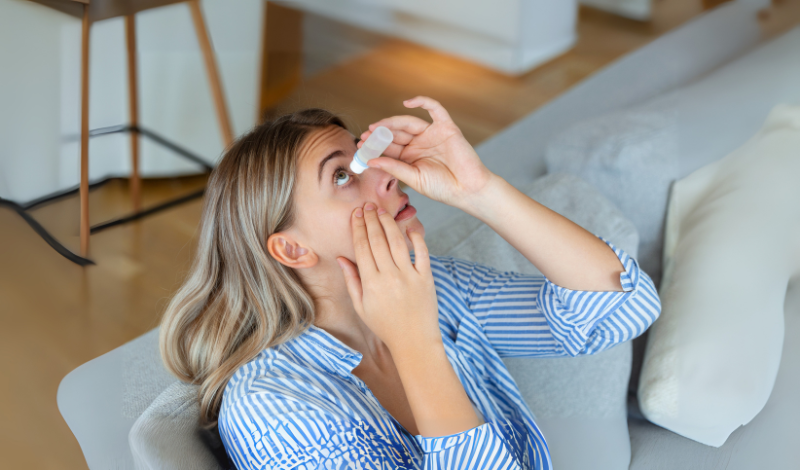In the present digital world, all of us spend most of the day looking at a screen, be it that of a smartphone, tablet, laptop, or desktop. Technology has made our lives easier. However, the exposure to screens for such long hours has a bad effect on our eyes too. Common symptoms that many people have include dry eyes, blurring vision, and sometimes even headaches, which most of the time can be associated with digital efficiency, or as often referred to as computer vision syndrome. Feel Good Contacts IE is trusted as a reliable Irish brand and stocks a wide range of affordable, quality eye care products, including contact lenses, eye drops, and screen protection accessories, to keep eyes healthy and refreshed throughout the day.
This guide breaks down practical steps and tools for eyesight protection in the modern digital age.
What Is Eye Strain and Why Does It Happen?
Eye strain happens when your eyes become tired after prolonged use, especially during screen use. The common symptoms include dry eyes, blurred vision, headaches, and sometimes neck or shoulder pain. It also comes with an eyestrain headache that results from too much screen use without appropriate breaks or postural support. If you start noticing pressure marks on your iPhone screen from incessantly tapping or staring down too closely, it could very well mean that you are too reliant on your smartphone.
What Causes Eye Strain From Screens?
Before diving into solutions, it’s essential to understand why eye strain from computer screens happens. Here are the primary causes:
- Prolonged focus: Staring at screens forces your eyes to constantly focus, which can exhaust the eye muscles.
- Reduced blinking: We blink 50% less when looking at screens, leading to dry and irritated eyes.
- Blue light exposure: Screens emit high-energy blue light that may contribute to retinal stress.
- Glare and brightness: Excessively bright screens or poor lighting increase visual discomfort.
- Poor posture and monitor distance: These factors contribute to both eye strain and neck pain.
How to Reduce Eye Strain: Common Practical Tips
Below are the most effective tips:
Follow the 20-20-20 Rule
The best and simplest remedy you can use to relieve eyestrain would be the 20-20-20 rule: every 20 minutes, look at something at least 20 feet away for 20 seconds. Quite honestly, this lets your eyes have a tiny break from keeping up with that close-up focus, reducing much of the fatigue and dryness.
Optimize Lighting and Reduce Glare
Make sure to avoid reflections on your screen by overhead lighting and bright sunlight directly hitting your display, as these glare and bright light are leading contributors to eye fatigue. Consider using an anti-glare screen protector, such as a computer screen vision protector or a PC screen protector for eyes, to make viewing more comfortable with fewer reflections.
Wear Glasses for Screen Use
Designed to block blue light and reduce glare, these specialized glasses for looking at a computer monitor often come with anti-reflective coating and slight magnification, assisting reading. Even if they aren’t prescription glasses, a pair of blue light-blocking glasses can certainly come in handy in protecting your eyes in extended screen time.
Use Protective Screen Films for Smartphones
Smartphones contribute greatly to digital eye strain. A protective screen for the monitor is fantastic, but don’t forget your phone. A simple yet effective way to protect your eyes while travelling is to use a protective smartphone screen monitor film for your smartphone that blocks blue light and helps reduce glare. These films can also prevent pressure marks from appearing on iPhone screens.
Don’t Ignore Symptoms
If your eyes hurt from screen use or you frequently notice headaches, do not just ignore these signs. Long-standing issues should be evaluated by a professional. Dry eye syndrome, astigmatism, or simply convergence insufficiency may worsen discomfort when working on a screen.
Know When to Seek Medical Advice
Any nagging discomfort, visual blurring, or headaches due to eye strain should be evaluated. If the question, “Why does my head hurt when I move my eyes?” is a frequent thought, then it might indicate something more serious such as an eye infection, optic neuritis, or even a migraine.
Conclusion
Reduce eye strain and protect your eyes from the stares of screens; in today’s digital world, simple things such as the 20-20-20 rule, modifying the screen settings, using a computer screen protector, and proper posture works wonders for your eyes. Not to mention blue light filters or protection screens for your monitor or smartphone. For the simple living, there are sites like Feel Good Contacts IE that offer a variety of vision care products, and as always, one can save on these essentials with deals like a savemydiscount. You will see the comfort of clearer vision tomorrow, when today is set aside for you to think of your eye health, dear.
Related Blog: Do I Need Glasses? 10 Signs You Shouldn’t Ignore
FAQs
What is the best monitor distance for eye comfort?
Position your screen about 20 to 30 inches (50 to 75 cm) from your eyes. The top of the screen should be at or slightly below eye level to reduce neck and eye strain.
What can I do about pressure marks on my iPhone screen?
Pressure marks on a phone screen may appear due to repeated touch or impact. While they don’t directly affect eye strain, they can distort screen clarity. Use a quality screen protector to reduce damage and visual discomfort.





